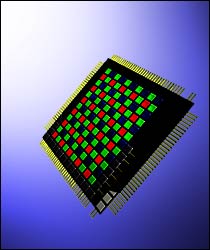
CCD (charge coupled device) and CMOS (complementary metal oxide semiconductor) image sensors are two different technologies for capturing images digitally. Each has unique strengths and weaknesses giving advantages in different applications. Neither is categorically superior to the other, although vendors selling only one technology have usually claimed otherwise. In the last five years much has changed with both technologies, and many projections regarding the demise or ascendence of either have been proved false. The current situation and outlook for both technologies is vibrant, but a new framework exists for considering the relative strengths and opportunities of CCD and CMOS imagers.
Cmos Sensor from Canon
The mediums used to record the image a traditional camera is the photographic or light sensitive film. Film is exposed to light and is later processed in chemicals to render an image. A digital camera however, does not use photographic film to record an image nor is there a chemical processing of the image. The digital camera works by using a light sensor or chip which absorbs light particles converting them into electrical charges. The light sensor is divided up into many small arrays of receptor cells. The more light these arrays of cells exposed the more light is recorded. These cells alone (with exceptions to emerging technologies such as Foveon x3) cannot recognize the different colors of the spectrum so during exposure primary colored filters are used in front of the image sensor which are a charged-couple device or CCD The charge generated by the CCD is stored as analogue information until it s digitised from analogue to digital converter or ADC. Every receptor in the array is equivalent to one pixel and it is the pixels that make up an image.
Not all digital cameras use CCD chips as image sensors. Some cameras use CMOS chips, or Complementary Metal Oxide Semiconductor. The CMOS based sensors are manufactured using the same process that is used to mass produce DRAM and microprocessors. CMOS sensors are cheaper and easier to manufacture than CCD chips, as they are smaller and more energy efficient than CCD's. Generally speaking, digital cameras that use CMOS chips are usually lighter than their CCD counterparts. However CMOS chips do have their drawbacks as they are less light sensitive. Using CMOS usually means sacrificing image quality. CMOS technology allows other circuitry to be incorporated into the same chips, making them useful to a manufacturer for use in other electronic applications.
Most digital cameras that you would be likely to encounter would be using the older CCD technology.

No comments:
Post a Comment